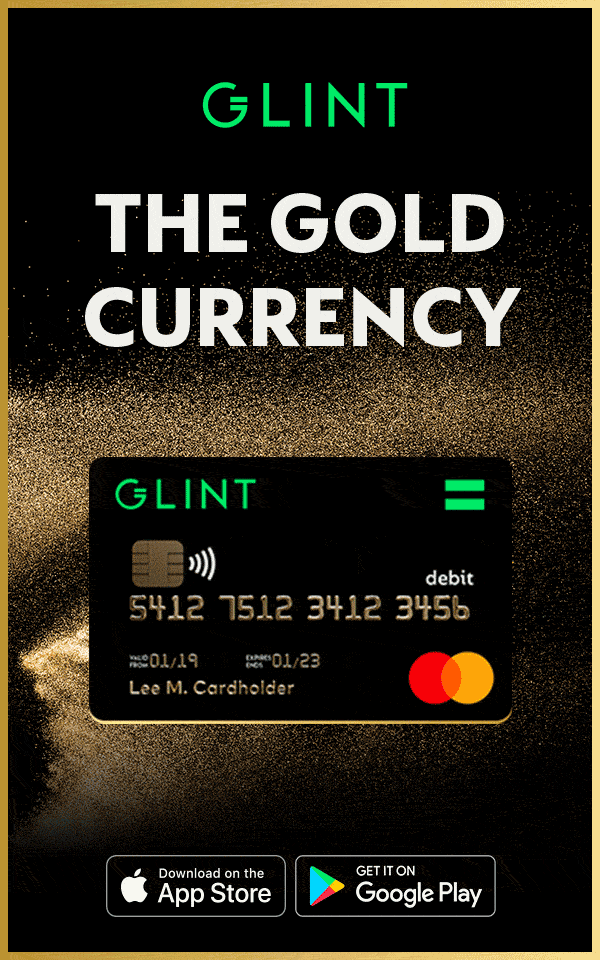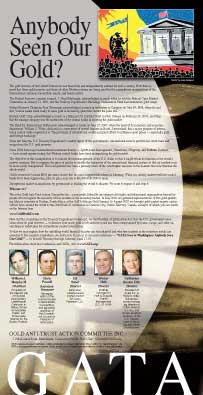You are here
A great photograph of ''Mister Gold,'' Jim Sinclair
Finding Comfort (and New Friends) in Gold
By Landon Thomas Jr.
The New York Times
Sunday, May 7, 2006
http://www.nytimes.com/2006/05/07/business/yourmoney/07gold.html?
_r=1&oref=
SHARON, Connecticut -- It's splendid spring day in Connecticut's
horse country and James E. Sinclair, perhaps the best-known gold
speculator of his era, is sitting before his trading terminal,
contemplating the upward thrust of gold on his trader's chart.
The sun, bursting through the bay windows, catches the glint of gold
that is everywhere in Mr. Sinclair's home office: on the coins near
his computer, on his chunky Rolex watch, on the rings on three of
his fingers, on the cuff links on his monogrammed shirt, and --
could it be? --a hint of it in his one working eye.
"I love gold, OK?" he said, his voice rising in excitement. "Gold
has made me wealthy. It feels nice. It's exchangeable. It's money."
On his television set, which is tuned to CNBC, news breaks of a
terrorist attack in Egypt, the price of oil pushes higher, and
traders continue to sell the dollar, which is approaching a one-year
low against the euro.
With gold trading at $683.80 an ounce, a 25-year high, it's a good
time to be a gold bug like Mr. Sinclair, especially if, like him,
you own a gold exploration company (his is in Tanzania) and were a
buyer when the metal sank as low as $250 an ounce in 2001. Now Wall
Street, traditionally a laggard when it comes to making the
investment case for gold, has jumped on Mr. Sinclair's bandwagon.
Investment banks like J.P. Morgan and Goldman Sachs are putting out
bullish research notes, retail investors are heavy buyers through
exchange-traded funds, and hedge funds; and the trading desks of
investment banks have been piling into the market, especially in the
last week.
For Mr. Sinclair, who rode the last bull market in gold to its peak,
in 1980, the surging price of his beloved metal is sending out clear
signals that take him back to the 1970s, when inflation, a weak
dollar, and an oil spike driven by turmoil in the Middle East
propelled gold to a high of $875 an ounce, or more than $1,800 in
current dollars after adjusting for inflation. His ultimate price
target now is not far from that: $1,650 an ounce, assuming that
things become really bad.
"Gold is a barometer of the common stock of a country, and right now
gold is sniffing out weakness in the management of the United States
as a business," said Mr. Sinclair, 65, a lifelong Republican who
twice voted for President Bush. "Iran is becoming a nuclear power.
The chairman of the Federal Reserve is on a puppet string controlled
by the White House, and there is no such thing as a strong-dollar
policy when the dollar is heading south."
For more than two decades, the apocalyptic lament of Mr. Sinclair
and other gold bugs has been largely dismissed as the United States
has experienced -- aside from a few hiccups -- a 25-year bull market
in a range of assets, from stocks and bonds to real estate and art.
Sustained by a continuing flood of liquidity, these assets have
continued their mighty climb, even as crucial gauges of economic
health in the United States -- the budget and current account
deficits -- have continued to worsen. But now, with gold making a
run for $700, dedicated gold investors are getting a wider hearing.
Their passion notwithstanding, gold bugs tend to be small-time
investors. Gold's recent surge has instead been underpinned by a
rush of mainstream investors, including hedge funds, commodity-based
mutual funds, and exchange-traded funds.
For these investors, gold is less a way of life than it is hedge
against inflation and a prudent measure of diversification during an
increasingly worrisome time. The extent to which this new wave of
capital remains invested in gold will determine if the recent spike
is just another anomaly or the onset of the second coming of the
great gold bull market that the true believers have been calling for
since the price of gold crashed a quarter-century ago.
Of course, many investors say that given gold's sharp recent climb,
a correction would not be surprising. It's another asset bubble,
they say, the latest investment fad. But for Mr. Sinclair and a
small clutch of other self-exiled Wall Streeters, the metal's recent
climb is just deserts for their unwavering if not mystical devotion
to gold as an investment, an adornment, a means of exchange, and,
more than anything else, a moral bulwark in a corrupting sea of
paper money, credit, and what they see as insidious financial
instruments.
Mr. Sinclair, who in the 1970s ran his own trading firm, achieved
his renown by selling 900,000 ounces of gold at an average price of
$810 in early 1980. That was when the metal was capping a decade-
long bull market that commenced in 1971, when President Richard M.
Nixon severed once and for all the dollar's link to gold.
In addition to selling his hoard, Mr. Sinclair sold his trading
business, took his total net gain of $18 million, and retreated here
to the Connecticut countryside, where he built his own private
Shangri-La. It is indeed, as Mr. Sinclair likes to call it, "the
house that gold built."
On the outskirts of Sharon, a village at the foot of the Berkshires,
the sprawling 38-acre estate includes an indoor swimming pool and
pistol range, horse stables, and a specially equipped garage that
once housed his collection of racing cars. It's a lot of property
for a solitary man -- his wife of 40 years died in a car crash in
India two years ago. Now, he uses his Web site (jsmineset.com),
books, DVD lectures, and cartoons that he commissions to proselytize
about the virtues of gold and the depredations of central bankers.
"This will be my last great ride," he said of the current spike in
gold prices. "Everybody loves to be right."
In Spain they call the obsession of some people to dig large holes
in the ground to search for the elusive ounce of gold "mal de
piedra," or the sickness of rocks -- one way, perhaps, to describe
the condition that affects Mr. Sinclair and his coterie of gold
investors.
With their missionary zeal and weakness for conspiracy theories,
gold lovers can seem a touch afflicted. They also collect and pass
around offbeat, brain-teasing findings. One is that the dollar has
lost 98 percent of its value since 1913, when the Federal Reserve
System was established. Another is an assertion by the American
Institute for Economic Research, an obscure research outfit in Great
Barrington, Mass., that since 1945 inflation has eroded $15.8
trillion from the savings accounts of United States citizens.
Both findings underscore their benchmark precept: that a currency
not tied to gold becomes debased when central banks print money and
governments spend freely. Perhaps Alan Greenspan, who before his run
as chairman of the Federal Reserve was highly regarded in gold-bug
circles, captured this point best. "In the absence of the gold
standard, there is no way to protect savings from confiscation
through inflation," he wrote in 1966, when he was an economic
consultant. "Gold stands in the way of this insidious process."
The great liquidity explosion that occurred under Mr. Greenspan has
made him a turncoat in the eyes of the gold-bug crowd. But his
successor, Ben. S. Bernanke, or "Helicopter Ben" as they call him,
inflames its passions all the more. To this group, Mr. Bernanke's
passing allusion -- before he became Fed chairman -- to a helicopter
dropping money over a recession-bound economy confirmed its deepest
fears that a monetary system not anchored by gold was essentially
inflationary if not downright immoral.
All the same, most mainstream economists accept that a return to the
gold standard and its restrictive covenants would be not only
unfeasible but also deflationary. Gold bugs may cry, and be correct,
about the creeping impact of inflation, but it is also true that the
same climb in prices, aided by the great liquidity boom, has made
some of them millionaires, as houses they bought for less than
$100,000 in the 1960s are now worth millions.
Like Mr. Sinclair, William J. Murphy III is also a Wall Street
refugee. After a one-year stint in 1968 as a wide receiver for the
New England Patriots, he began a career as a commodities trader,
working for a number of firms, including Shearson and Drexel
Burnham. Convinced that the price of gold was being suppressed by an
unholy alliance between the central banks and major investment
banks, he formed the Gold Anti-Trust Action Committee, known as
GATA, that seeks to publicize facts and assertions that support his
point -- namely that the gold reserves in central banks are
significantly overstated.
GATA for the most part is a one-man show -- Mr. Murphy, dressed in
his sweatsuit, perched in front of the computer in his home in
suburban Dallas. With his excitable manner and his outr theories
about gold, he is generally thought to exist on the outer fringe of
the gold-bug movement.
Indeed, his central thesis -- that Goldman Sachs and other banks
have conspired to keep a cap on the price via short sales to back
the government's strong-dollar policy, especially while a former
Goldman senior partner, Robert E. Rubin, was Treasury secretary in
the late 1990s -- is far-fetched.
With the price of gold surging, Mr. Murphy is convinced that Goldman
Sachs, J. P. Morgan, and others are frantically buying now to cover
for the gold they sold short over the years. Goldman Sachs and J. P.
Morgan declined to comment about their gold trading positions or
strategies.
"What a day," Mr. Murphy said one day last week as gold broke
through $670. Goldman Sachs and J. P. Morgan were big buyers that
day on Comex, the division of the New York Mercantile Exchange where
gold contracts trade. Sputtering at the joy of it all, Mr. Murphy
could well have been a prospector hitting the Mother Lode. "These
guys are short, and they are panicking to get out of their
positions," he said. "They are sweating bullets, and it couldn't
happen to a nicer bunch of guys."
There is a kernel of truth to what Mr. Murphy says. Central banks
have been aggressive sellers of gold, especially in the late 1990s,
when gold was touching record lows. But most economists say that
there was no grand design involved, just a badly timed attempt to
shift into higher-yielding assets like bonds.
As for investment banks, they are sellers and buyers of any given
asset at any given time. But it is also true that they have hardly
been enthusiastic advocates for gold as an investment, especially
when the stock market was king. Even now, as they have issued
positive reports about the metal, their price targets seem oddly out
of sync with its relentless rise.
Goldman's forecast for a year-end price is $625 an ounce; J. P.
Morgan's target, which is currently under review, is $560, and
Morgan Stanley's is $550.
Compared with Mr. Murphy and his boylike excitability, James Turk
speaks with an assured gravity consistent with his background as a
commercial banker at Chase Manhattan. But his views about gold as
the ultimate store of value in a financial world on the verge of
collapse are no less doctrinaire.
Indeed, Mr. Turk has established his own online payment system,
GoldMoney.com, through which he and his fellow gold bugs may enjoy
the thrill of buying goods and services via gold, not cash.
In some ways it is a symbolic exercise. While the payment system is
supported by $100 million worth of gold, no merchants have agreed to
take bullion as payment, although Mr. Turk hopes that day may come.
More than anything else, the site demonstrates his disdain for the
dollar and all other forms of paper money -- a view that he often
heard from his parents, who experienced the ravages of
hyperinflation in Austria in the 1920s.
"It's not gold going up; it's the dollar going down," Mr. Turk said
by phone from Australia, where he was speaking at an investment
conference. Gold has held its value much better than the dollar
against commodities like oil, he said.
With oil hitting new highs -- it has hovered around $70 a barrel for
weeks -- Mr. Turk foresees a return to the 1970s, when high
inflation and a volatile Middle East drove gold to its peak. "If we
get close to $850 this year, it's most probable that we will see a
four-digit gold price in 2007," he said. Four-digit gold -- an ounce
of bullion selling for $1,000 or more -- is the gold bugs'
equivalent of a visit from the Messiah.
But for the growing number of hedge funds that are piling into the
commodity, gold is less a virtuous investment than it is a mercenary
one.
China and India are buying more gold. Iran is becoming more
bellicose in its stand toward the West. And, most important,
liquidity is making a broad shift to commodities and out of stocks.
"Do I think that gold is God? No," said Monty Guild, who runs Guild
Investment Management, a hedge fund in Malibu, Calif. "I'm a gold
opportunist. When it's good, we like it; when it's not, we stay
away. Gold does well during wars, and we believe there will be more
wars."
And for those not in gold, or any other highflying commodity, for
that matter, the feeling can be lonely. William H. Miller III,
portfolio manager of the $19 billion Legg Mason Value Trust, which
has beaten the Standard & Poor's 500-stock index for 15 consecutive
years, has no gold in the fund. His view is that inflationary
expectations, if not prices themselves, remain quiescent, and that
gold -- like oil, emerging markets, and small-cap stocks before it --
has become the latest investment craze, propelled upward by a wave
of hot money, a term for speculative short-term capital.
"Gold certainly looks extended from here," said Mr. Miller, whose
fund is currently trailing the S.& P. 500 for the year. "It's easy
to make money when you are trend-following," he added. "But if you
are worried that the end is near, the last thing I want is gold
because of all the hot money."
----------------------------------------------------
To subscribe to GATA's dispatches, send an e-mail to:
gata-subscribe@yahoogroups.com
To unsubscribe, send an e-mail to:
gata-unsubscribe@yahoogroups.com
Caution: America Online prohibits delivery of GATA
dispatches to AOL e-mailboxes.
----------------------------------------------------
RECOMMENDED INTERNET SITES
FOR DAILY MONITORING OF GOLD
AND PRECIOUS METALS
NEWS AND ANALYSIS
Free sites:
http://www.cbs.marketwatch.com
http://www.usagold.com/amk/usagoldmarketupdate.html
http://www.capitalupdates.com/
http://www.silver-investor.com
http://www.thebulliondesk.com/
http://www.goldismoney.info/index.html
http://www.minersmanual.com/minernews.html
http://www.a1-guide-to-gold-investments.com/euro-vs-dollar.html
http://www.investmentrarities.com
http://www.kereport.com
(Korelin Business Report -- audio)
http://www.plata.com.mx/plata/home.htm
(In Spanish)
http://www.plata.com.mx/plata/plata/english.htm
(In English)
http://www.resourceinvestor.com
http://www.goldpennystocks.com/
Subscription sites:
http://www.lemetropolecafe.com/
http://www.interventionalanalysis.com
http://www.investmentindicators.com/
Eagle Ranch discussion site:
http://os2eagle.net/checksum.htm
Ted Butler silver commentary archive:
http://www.investmentrarities.com/
----------------------------------------------------
COIN AND PRECIOUS METALS DEALERS
WHO HAVE SUPPORTED GATA
AND BEEN RECOMMENDED
BY OUR MEMBERS
Blanchard & Co. Inc.
909 Poydras St., Suite 1900
New Orleans, Louisiana 70112
888-413-4653
http://www.blanchardonline.com
Centennial Precious Metals
Box 460009
Denver, Colorado 80246-0009
1-800-869-5115
http://www.USAGOLD.com
Michael Kosares, Proprietor
cpm@usagold.com
Colorado Gold
222 South 5th St.
Montrose, Colorado 81401
http://www.ColoradoGold.com
Don Stott, Proprietor
1-888-786-8822
Gold@gwe.net
El Dorado Discount Gold
Box 11296
Glendale, Arizona 85316
http://www.eldoradogold.net
Harvey Gordin, President
Office: 623-434-3322
Mobile: 602-228-8203
harvey@eldoradogold.net
Gold & Silver Investments Ltd.
Mespil House
37 Adelaide Rd
Dublin 2
Ireland
+353 1 2315260/6
Fax: +353 1 2315202
http://www.goldinvestments.org
info@gold.ie
Investment Rarities Inc.
7850 Metro Parkway
Minneapolis, Minnesota 55425
http://www.gloomdoom.com
Greg Westgaard, Sales Manager
1-800-328-1860, Ext. 8889
gwestgaard@investmentrarities.com
Kitco
178 West Service Road
Champlain, N.Y. 12919
Toll Free:1-877-775-4826
Fax: 518-298-3457
and
620 Cathcart, Suite 900
Montreal, Quebec H3B 1M1
Canada
Toll-free:1-800-363-7053
Fax: 514-875-6484
http://www.kitco.com
Lee Certified Coins
P.O. Box 1045
454 Daniel Webster Highway
Merrimack, New Hampshire 03054
http://www.certifiedcoins.com
Ed Lee, Proprietor
1-800-835-6000
leecoins@aol.com
Lone Star Silver Exchange
1702 S. Highway 121
Suite 607-111
Lewisville, Texas 75067
214-632-8869
http://www.discountsilverclub.com
MRCS Canada
12303-118 Ave. NW
Edmonton, Alberta T5L 2K2
Canada
http://www.mrcscanada.com
Michael Riedel, Proprietor
1-877-TRY-MRCS
1-877-879-6727
mrcscanada@shaw.ca
Miles Franklin Ltd.
3015 Ottawa Ave. South
St. Louis Park, Minn. 55416
1-800-822-8080 / 952-929-1129
fax: 952-925-0143
http://www.milesfranklin.com
Contacts: David Schectman,
Andy Schectman, and Bob Sichel
Missouri Coin Co.
11742 Manchester Road
St. Louis, MO 63131-4614
info@mocoin.com
314-965-9797
1-800-280-9797
http://www.mocoin.com
Resource Consultants Inc.
6139 South Rural Road
Suite 103
Tempe, Arizona 85283-2929
Pat Gorman, Proprietor
1-800-494-4149, 480-820-5877
Metalguys@aol.com
http://www.buysilvernow.com
Richard Nachbar Rare Coins
5820 Main St., Suite 601
Williamsville, N.Y. 14221-8232
877-622-4227
http://www.CoinExpert.com
nachbar@coinexpert.com
Swiss America Trading Corp.
15018 North Tatum Blvd.
Phoenix, Arizona 85032
http://www.swissamerica.com
Dr. Fred I. Goldstein, Senior Broker
1-800-BUY-COIN
FiGoldstein@swissamerica.com
The Moneychanger
Box 178
Westpoint, Tennessee 38486
http://www.the-moneychanger.com
Franklin Sanders
1-888-218-9226, 931-766-6066
----------------------------------------------------
HOW TO HELP GATA
If you benefit from GATA's dispatches, please
consider making a financial contribution to
GATA. We welcome contributions as follows.
By check:
Gold Anti-Trust Action Committee Inc.
c/o Chris Powell, Secretary/Treasurer
7 Villa Louisa Road
Manchester, CT 06043-7541
USA
By credit card (MasterCard, Visa, and
Discover) over the Internet:
http://www.gata.org/creditcard.html
By GoldMoney:
http://www.GoldMoney.com
Gold Anti-Trust Action Committee Inc.
Holding number 50-08-58-L
Donors of $200 or more will receive copies
of "The ABCs of Gold Investing" by Michael
Kosares, proprietor of Centennial Precious
Metals in Denver, Colorado, and "The Coming
Collapse of the Dollar" by James Turk and
John Rubino.
GATA is a civil rights and educational
organization under the U.S. Internal Revenue
Code and contributions to it are tax-deductible
in the United States.








